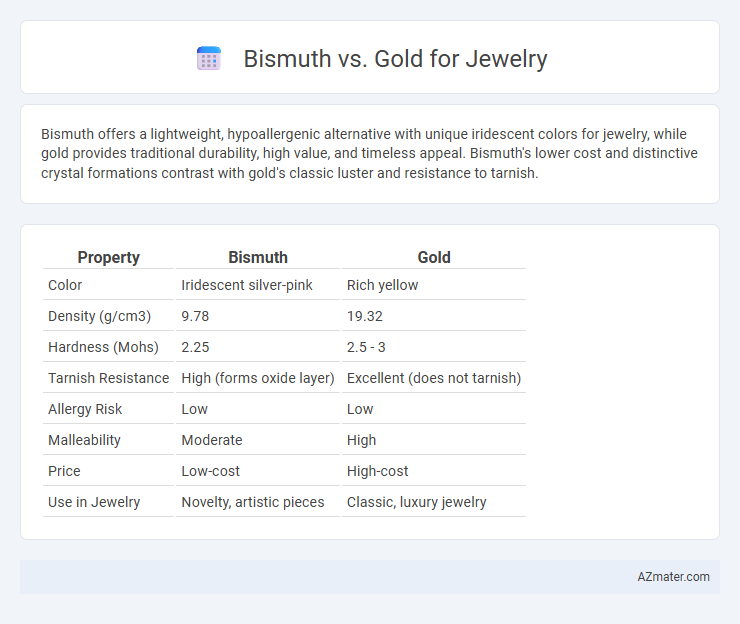Bismuth offers a lightweight, hypoallergenic alternative with unique iridescent colors for jewelry, while gold provides traditional durability, high value, and timeless appeal. Bismuth's lower cost and distinctive crystal formations contrast with gold's classic luster and resistance to tarnish.
Table of Comparison
| Property | Bismuth | Gold |
|---|---|---|
| Color | Iridescent silver-pink | Rich yellow |
| Density (g/cm3) | 9.78 | 19.32 |
| Hardness (Mohs) | 2.25 | 2.5 - 3 |
| Tarnish Resistance | High (forms oxide layer) | Excellent (does not tarnish) |
| Allergy Risk | Low | Low |
| Malleability | Moderate | High |
| Price | Low-cost | High-cost |
| Use in Jewelry | Novelty, artistic pieces | Classic, luxury jewelry |
Introduction to Bismuth and Gold in Jewelry
Bismuth and gold are unique metals used in jewelry, each offering distinct properties and aesthetic appeal. Bismuth features a low toxicity level, iridescent colors, and geometric crystal formations, making it popular for unconventional, eye-catching designs. Gold, prized for its ductility, durability, and rich yellow hue, remains a timeless choice in fine jewelry, often alloyed with metals like copper or silver to enhance strength and color variations.
Physical Properties: Bismuth vs Gold
Bismuth exhibits a low density of 9.78 g/cm3 and a distinctive iridescent, rainbow-colored oxide surface, contrasting sharply with gold's high density of 19.32 g/cm3 and its characteristic yellow metallic luster. While gold is highly malleable and ductile, allowing for intricate jewelry designs, bismuth is brittle and prone to fracturing under stress, limiting its use in fine jewelry applications. The melting point of bismuth is 271.5degC, much lower than gold's 1064degC, affecting casting methods and durability in jewelry production.
Visual Appeal and Color Variations
Bismuth jewelry offers a unique, iridescent color palette ranging from blues and pinks to greens due to its oxide surface, creating a striking rainbow effect that differs significantly from the classic, warm yellow tones of gold. Gold jewelry provides timeless elegance with consistent shades of yellow, white, or rose gold, prized for its lustrous and highly reflective finish. The vibrant, geometric crystal structures of bismuth appeal to those seeking unconventional, eye-catching pieces, while gold remains a symbol of traditional luxury and enduring value.
Durability and Wearability Comparison
Bismuth jewelry offers unique iridescent colors but is significantly less durable than gold, making it prone to scratching and damage with everyday wear. Gold, especially in higher karats like 18K or 24K, provides superior strength, resistance to tarnish, and excellent longevity for daily use. For wearability, gold's hypoallergenic properties and malleability ensure comfort and lasting beauty, while bismuth's brittleness limits its practical use in frequently worn pieces.
Hypoallergenic Qualities: Which Is Safer?
Bismuth is widely recognized for its hypoallergenic properties, making it a safer choice for individuals with sensitive skin or metal allergies compared to gold, which often contains trace amounts of nickel or other alloying metals that can trigger reactions. Pure gold (24k) is naturally hypoallergenic, but its softness necessitates mixing with other metals, potentially compromising its safety for allergy sufferers. Therefore, bismuth jewelry offers an excellent alternative for hypoallergenic wearers seeking unique, non-toxic materials.
Cost Differences: Bismuth vs Gold Jewelry
Bismuth jewelry offers a significantly lower cost compared to gold, making it an affordable alternative for stylish and unique pieces. While gold prices fluctuate around $60 per gram, bismuth costs only a fraction, often under $1 per gram, drastically reducing the overall expense of crafting jewelry. This substantial price difference makes bismuth an attractive choice for budget-conscious consumers seeking distinctive designs without the premium cost of precious metals like gold.
Environmental and Ethical Considerations
Bismuth presents a more environmentally sustainable alternative to gold due to its lower environmental impact during mining and its non-toxic nature, reducing pollution and health risks. Gold mining often involves extensive use of harmful chemicals like cyanide and mercury, contributing to significant ecological degradation and ethical concerns such as child labor and poor working conditions. Choosing bismuth for jewelry supports eco-friendly practices and responsible sourcing, aligning with growing consumer demand for sustainable and ethical materials.
Versatility in Jewelry Design
Bismuth offers unique, iridescent hues and geometric crystal formations that provide avant-garde versatility in jewelry design, appealing to modern and artistic styles. Gold, valued for its classic warm luster and malleability, remains a timeless choice adaptable for intricate and traditional jewelry craftsmanship. Designers often choose bismuth for statement pieces while gold is preferred for its durability and broad acceptance in various jewelry forms.
Maintenance and Care Requirements
Bismuth jewelry requires gentle cleaning with a soft cloth and mild soap to preserve its iridescent surface, avoiding harsh chemicals that can damage its fragile crystalline structure. Gold jewelry, known for its durability, can be cleaned more aggressively using jewelry-specific cleaners or a mixture of warm water and dish soap without risk of surface damage. While gold resists tarnishing and corrosion, bismuth is more prone to oxidation and scratching, necessitating careful handling and storage in a dry, padded environment.
Conclusion: Choosing Between Bismuth and Gold
Bismuth offers a unique, iridescent appearance and is highly affordable, making it ideal for fashion-forward, budget-conscious jewelry buyers seeking distinctive pieces. Gold provides timeless value, durability, and traditional elegance, favored for investment and classic luxury jewelry. The choice depends on whether the priority is artistic expression and cost-effectiveness (bismuth) or enduring worth and conventional prestige (gold).

Infographic: Bismuth vs Gold for Jewelry
 azmater.com
azmater.com